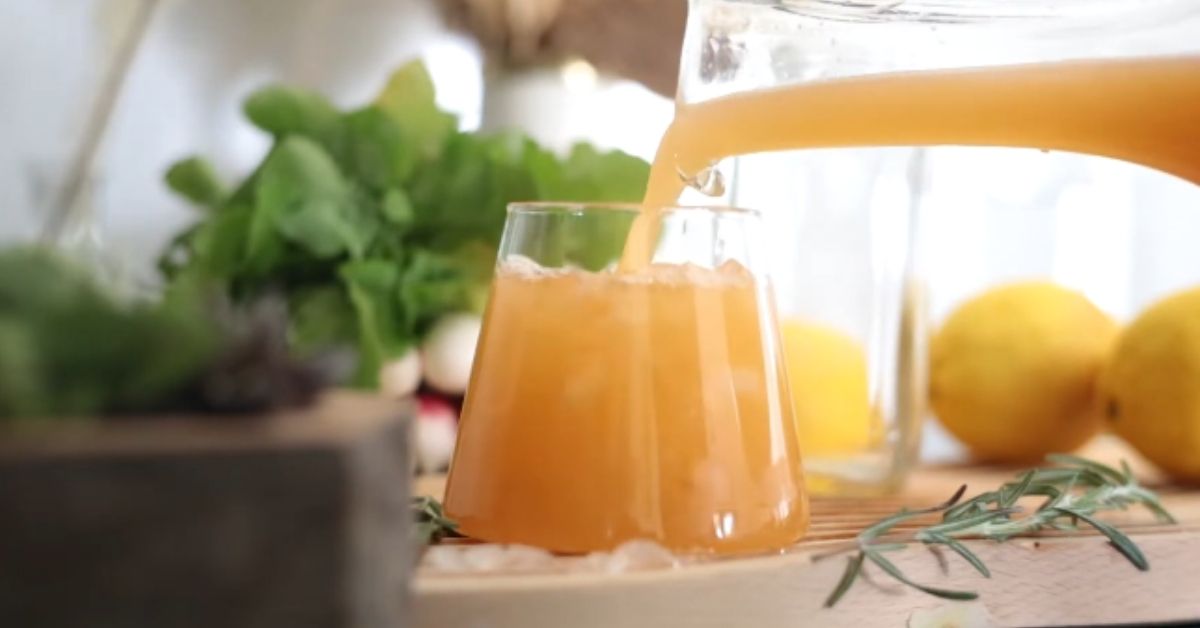Imagine starting your day with a burst of flavor that not only delights your taste buds but also combats inflammation. Juices packed with anti-inflammatory properties can be a delicious gateway to improved health. From the vibrant turmeric root to the powerful punch of ginger, these natural ingredients are renowned for their ability to reduce inflammation and boost overall wellness.
Incorporating these juices into your diet is simple and effective. Whether you’re dealing with chronic inflammation or just looking for a refreshing way to stay healthy, these recipes are designed to be both nutritious and delicious. Get ready to blend your way to better health with juices that are as beneficial as they are beautiful.
Ingredients
Kick-start your morning with these powerful, anti-inflammatory ingredients. They’re not only beneficial for your health but also delicious and easy to integrate into your daily routine.
Anti-Inflammatory Juice Ingredients
- Fresh Turmeric Root: 3 inches, peeled and chopped
- Ginger Root: 2 inches, peeled and chopped
- Carrots: 4 large, peeled
- Apples: 2 large, cored and sliced
- Oranges: 2, peeled and quartered
- Lemon: 1, peeled and quartered
- Pineapple: 1 cup, chopped
- Cucumber: 1 large, adds freshness and volume
- Celery Stalks: 2, for a hint of natural saltiness and additional anti-inflammatory benefits
- Fresh Mint Leaves: A handful for a refreshing twist
- Kale Leaves: 2 large, to boost the green nutrients
- Beetroot: 1 small, peeled and chopped, for earthiness and vibrant color
Tools and Equipment Needed
To transform the anti-inflammatory ingredients into refreshing and beneficial juices, you’ll need specific tools and equipment. Ensuring you have the right tools on hand will streamline the juicing process and enhance your overall experience.
Juicer
A high-quality juicer is essential for extracting juice efficiently from a variety of fruits and vegetables such as carrots, apples, and leafy greens. Choose a masticating juicer if you prefer to retain more fiber and nutrients, or opt for a centrifugal juicer for its speed and ease of use.
Blender
For ingredients like pineapple and cucumber that blend well, a powerful blender can be useful. This helps in creating a smoother juice, especially if you like to mix textures or add ingredients such as mint leaves or ginger for a flavor kick.
Knife and Cutting Board
A sharp knife and sturdy cutting board will be required to prep your ingredients. Make sure your knife is well honed to easily handle cutting through tougher ingredients like beetroot and ginger.
Measuring Cups and Spoons
Accurate measurements ensure that your juices have the perfect balance of flavors. Measuring cups and spoons are useful for dosing ingredients like turmeric and lemon juice.
Strainer or Cheesecloth
If you prefer your juice without pulp or bits of fiber, using a strainer or cheesecloth will help you achieve a smooth texture. This is particularly useful when juicing leafy greens such as kale or mint.
Citrus Juicer
Incorporate a handheld citrus juicer to easily extract juice from oranges and lemons without the bitterness of the rind. This tool is handy for adding a zesty note to your juices.
Storage Containers
If you plan to make juice in batches, high-quality storage containers are crucial for keeping your juice fresh. Opt for airtight containers to retain the nutrients and flavors of the juice for longer.
Equipping yourself with these tools will ensure that your juicing process is efficient and effective, allowing you to enjoy the maximum health benefits from your anti-inflammatory juices.
Preparation Steps
Now that you have your juicing tools ready, let’s dive into the actual preparation of your anti-inflammatory juices.
Washing and Peeling
Begin by thoroughly washing all fruits and vegetables under cold running water to remove any dirt or residues. It’s crucial to clean even those produce items you plan to peel to prevent cross-contamination. For ingredients like ginger and turmeric, use a small brush to scrub their skin gently, which can harbor dirt in its crevices. Peel the skin off the turmeric and ginger using a peeler or a small knife, as these skins can be tough and fibrous. For fruits like apples and pears, peeling is optional depending on your preference for texture and fiber content in your juice.
Chopping and Prepping Vegetables and Fruits
After washing and peeling, move on to chopping your ingredients. Chop the peeled turmeric and ginger into small pieces—this helps in extracting the maximum amount of juice and nutrients. For leafy greens like kale, remove the stems and roughly chop the leaves; this will make them easier to process through the juicer. Apples and pears should be cut into quarters, removing the cores. Ensure all pieces are small enough to easily fit into the feed chute of your juicer, which typically means cutting them into pieces no larger than an inch or two. This not only aids in more efficient juicing but also helps in protecting your juicer from potential damage caused by overloading.
Juicing Instructions
Once you have your anti-inflammatory ingredients washed, peeled, and chopped, it’s time to transform them into a nutritious juice. Following these steps ensures that you extract the maximum amount of nutrients.
Blending Juice Ingredients
Begin by placing your prepared ingredients such as turmeric, ginger, and kale into the blender. If the ingredients are tough or fibrous, consider adding a small amount of water or natural juice to help the blending process. Secure the lid and start blending at a low speed, gradually increasing to high speed. Blend until the mixture appears smooth and evenly processed, which typically takes about 1-2 minutes depending on your blender’s power.
Straining for Smoother Juice
To achieve a smoother juice consistency, pour the blended mixture through a fine mesh strainer or a nut milk bag over a large bowl. Use a spatula or the back of a spoon to press the pulp against the strainer, extracting as much liquid as possible. Discard the remaining pulp or save it for use in compost or recipes. Pour your strained juice into a serving glass or storage container. Enjoy your juice immediately to benefit from its full nutritional value, or store it in the refrigerator for up to 24 hours.
Serving Suggestions
After creating your anti-inflammatory juice, serving it correctly can enhance its benefits and enjoyment. Here are a few tips to ensure the best experience.
Best Practices for Serving
To maximize the benefits and taste of your freshly made juice:
- Serve Immediately: Drink the juice right after preparation to benefit from all the nutrients before they degrade.
- Chill, Don’t Freeze: Cooling the juice in the refrigerator for about 30 minutes can refresh its flavor without compromising the nutrients.
- Proper Glassware: Use a clear, tall glass to enhance the visual appeal of the vibrant colors of your juice.
- Garnish Wisely: Add a slice of lemon, lime, or a sprig of mint to the rim of your glass for an extra touch of flavor and flair.
- Dilution for Palate Preference: If the juice is too potent, dilute it with a small amount of cold water or coconut water until it suits your taste.
Incorporating these practices will help transform your juice into a delightful wellness drink that not only tastes good but also combats inflammation with every sip.
Make-Ahead Tips
Preparing these inflammation-fighting juices in advance can save you time and help maintain their robust nutritional profile. Follow these strategic storage tips to enjoy your healthy juices all week.
How to Store Fresh Juice
To ensure your batch of anti-inflammatory juice remains potent and delicious, proper storage is crucial. Start by choosing the right container; glass or BPA-free plastic bottles are best. Always sterilize your storage containers before use to remove any harmful bacteria and preserve the quality of the juice.
When pouring the juice, fill the containers to the brim to minimize the air space, which helps prevent oxidation that can degrade nutrients quickly. Seal the containers tightly and store them in the coldest part of your refrigerator, usually at the back, keeping them away from light and heat, which can also affect the juice’s freshness.
Ideally, consume your juice within 48 hours. However, if you’ve used a masticating juicer, your juice may stay fresh for up to 72 hours with minimal nutrient loss. Always give the bottle a good shake before drinking, as natural separation is likely to occur.
Conclusion
Embracing the power of anti-inflammatory juices can significantly enhance your health and well-being. By incorporating ingredients like turmeric, ginger, and kale into your daily routine, you’re not just enjoying a refreshing drink but also giving your body a nutrient-rich boost to fight inflammation. Remember to follow the juicing tips shared to get the most out of your ingredients and to store your juices properly to retain their health benefits. Cheers to a healthier, more vibrant you!
Related Posts:
- Natural vs Refined Sugar: Health, Environmental, and Economic Impacts
- Pasteurized vs Unpasteurized Juice: A Comprehensive Guide to Safety and Nutrition
- Managing IBS Symptoms: Effective Carbohydrate Choices and Tips
- Ketogenic Juicing Guide: Low-Carb Recipes & Essential Tips
- Top Homemade Juice Recipes to Lower Cholesterol & Boost Heart Health
- Stomale-Friendly Meals: Top Recipes & Tips for Stomach Ulcer Relief
- Ultimate Brain Detox Juice Recipe for Enhanced Cognitive Health
- Lung Juice: Boost Your Respiratory Health with This Ginger-Lemon-Honey Beverage
- Quick Turmeric Juice Recipe for Inflammation Relief & Health
- Top Juices for Inflammation Relief: Tips and Recipes


